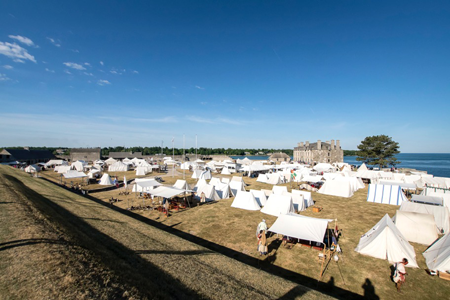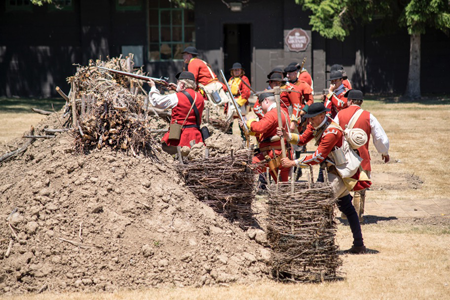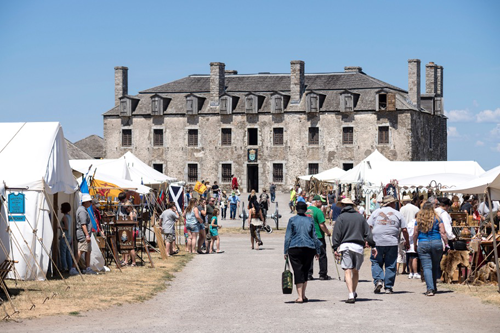Old Fort Niagara is getting ready to let visitors get their hands dirty at this year's French and Indian War Encampment, July 1-3, on the very soil where French, British and Native soldiers dirtied their hands in July 1759.
As hundreds of staff, volunteers and re-enactors come together to stage the dramatic siege of the French Fort Niagara by the British, the public will have access to hands-on activities, demonstrations and special tours.
"Life in the trenches in 1759 was far from fun, but as a visitor, it is fun to get your hands dirty and get a sense of what it's like to re-enact history," said Robert Emerson, executive director of the Old Fort Niagara Association. "At this year's encampment, we're offering the kinds of hands-on, in-the-trenches learning that visitors like."
Among the demonstrations are: learning manual exercises with wooden muskets, carrying barrels and trade bales to help the French fortify the earthworks, sewing sandbags, handling Native trade goods and furs, and playing period games.
Demonstrations include: engineering and exhibition of 18th century trench defenses; French women sewing sandbags and powder bags, and treating the wounded; British artillery firing on the French and French firing on the British; Natives and French trading furs for European goods; British and French preparing food and feeding the troops; Natives playing lacrosse; and French, British and Native sutlers (period merchants) demonstrating and selling handmade products such as pottery, ironworks, clothing, soap and food.
Siege and battle tours during the encampment will help narrate the sequence of historic events being portrayed on the fort grounds. Visitors are invited to accompany tour interpreters as they set the stage for the conflict being re-enacted around them.
"Our visitors' enthusiasm for living history at the French and Indian War Encampment is contagious," Emerson added. "When your job is sharing history, whether you're an employee, re-enactor or volunteer, there is nothing better than seeing people enjoy what you're teaching them. We encourage local residents and out-of-towners to come make some fun, early-summer memories with us."
The fort's hours will be 9 a.m. to 7 p.m. daily (admissions end at 6:30 p.m.). Visitors should arrive 30 minutes to an hour before battles to allow time to get through admissions and to the viewing areas.
Saturday, July 1
9:30 a.m. Siege Tour: The French Rebuild Fort Niagara 1755-59 (historical background tour)
This special tour will explore the physical history of the fort during the French and Indian War. The tour will touch on military engineering practices of the 1750s and how they were employed to better defend Fort Niagara.
10 a.m. The Fur Trade (hands-on): Natives and French traders gather to barter furs for European goods. Witness the fur trade, which was brisk at Niagara during May and June 1759. Handle sample trade goods and furs.
10:30 a.m. French Colors Ceremony: The garrison assembles in front of the castle to troop the colors. Afterward, a small hunting party leaves the fort to seek game in the woods to the east of the fort.
11 a.m. The British Advance (historical background vignette and uniform program): Discover the story behind the planning and execution of the British campaign. Meet British and Provincial soldiers, and Native warriors who took part in the 1759 campaign.
11:15 a.m. The Pigeon Hunters (historical background vignette): French hunters approach the woods line, when they are fired on and seized by Native warriors. One man escapes and sprints for the fort. A detachment from the fort soon appears to investigate. Suddenly, British regulars begin to fire volleys from the woods line, backed up by Native warriors. French troops return fire, but are slowly pushed back toward the fort.
11:30 a.m. Interrogation (historical background vignette): British officers question the French prisoners about the strength of the fort.
12:30 p.m. Preparing the Fort for Siege (hands-on): Portraying the events of July 6-8, French defenders prepare the fort for siege. Soldiers move barrels and trade bales into the ravelin (outer earthwork defenses) for additional cover. Meet the French soldiers, miliciens and Natives who will defend the fort from attack.
1 p.m. Rutherford's Embassy (historical background vignette): British Capt. Walter Rutherford appears with a small party and requests a parley. He is met, blindfolded and brought to the French Castle, where he delivers a surrender demand to Capt. Pouchot.
1:30 p.m. Opening the Sap (military science background tour): Capt.-Lt. Williams discusses how the British intend to approach Fort Niagara, how saps (trenches) are laid out and constructed.
2 p.m. Battle Demonstration: The French sortie (battle and artillery re-enactment). Events of July 9-11. A British work party enters the sap with a trench guard. The French sally from the fort's defenses, driving the British back. Drums roll in the British camp, and British forces counterattack, driving the French back to the fort. The French retreat back to the fort under cover of artillery.
3 p.m. British Mortars: British mortar demonstration in the sap.
3:15 p.m. Kaendae's Embassy I (historical background vignette): With Sir William Johnson in attendance, Kaendae, a Haudenosaunee leader, holds council in the British camp. Six Nations warriors agree to withdraw from the siege and camp at La Belle Famille, a site one mile south of the fort.
4 p.m. French batteries resume fire
The sun rises on the French camp at Old Fort Niagara's French and Indian War Encampment.
Sunday, July 2
9:15 am: Military Church Service
10:30 a.m. Kaendae's Embassy II (historical background vignette): At the castle, Capt. Pouchot makes a speech, reproaches the Senecas for allying with the British, and invites them to extricate themselves from the siege. Potawatomie and Mississauga in the fort also address the delegates. Six Nations delegates leave the fort.
11 a.m. Siege Tour (historical background tour): The British advance the sap and trade small arms fire with the French, who also continue to fire artillery. An interpreter conducts a tour around the periphery of this action, explaining what is happening.
Noon Foodways: Demonstration of camp cooking at the British camp.
1 p.m. Siege Tour: British Batteries (historical background tour): British guns are brought forward and open up on the fort. Artillery and engineering demonstration.
2 p.m. Battle Demonstration: British assault on the fort (battle and artillery re-enactment). British forces make an assault on the fort but are driven back by French fire.
3 p.m. Women's Program (hands on): French women sew sandbags and powder bags, and treat the wounded. An interpreter explains the role of women in the siege.
4 p.m. 18th Century Games (hands-on)
Battle and artillery demonstrations are ongoing for three days during the French and Indian War Encampment as the French, wearing ivory here, and British, wearing red, recreate the siege of Fort Niagara, the gateway to the inner continent.
Monday, July 3
9 am: Lacrosse game on parade ground
10 a.m. Siege Tour (historical background tour): Both sides enter the lines and trade musket and cannon rounds.
11 a.m. Battle Demonstration: La Belle Famille (battle re-enactment). Events of July 24. The French relief force tries to break through to Fort Niagara, but is stopped by British regulars under Col. Massey.
Noon Artillery Demonstration: British guns pound the fort. French return fire.
1 p.m. Desperate Measures (historical background vignette): Events of July 21-24. British small arms and artillery continue to pound the fort. Many French guns are dismounted and men refuse to fire over the parapet. Officers try to motivate their men to continue the defense of the fort.
2 p.m. Battle Demonstration: British Assault the Fort (battle re-enactment). The British successfully assault the outer works. French sue for terms.
2:45 p.m. Surrender Ceremony: British troops enter the fort. French troops formed on parade ground, Natives acquire French goods, fort surrenders.
Additional Information
Food, snacks, drinks and ice cream will be available for sale each day from 11 a.m. to 4 p.m. at the log cabin and adjacent food tent.
The fort's Officers' Club and its new Fort Niagara displays (post-Civil War through 1963) will be open to the public from 10 a.m. to 4 p.m. daily.
Everything is included in the $13 admission price (children ages 5 and under are admitted free). Admission is also free for Old Fort Niagara Association members. However, note that new or renewed memberships to the Old Fort Niagara Association will not be processed onsite during the French and Indian War Encampment. Memberships can be purchased online at
www.oldfortniagara.org/membership/registration.
Youngstown's Old Fort Niagara (
www.oldfortniagara.org) is open daily from 9 a.m. to 5 p.m. through June and from 9 a.m. to 7 p.m. in July and August. Admissions end 30 minutes before closing.
British, French and Native camps and sutlers share their stories, trades and hand-made goods at the French and Indian War Encampment at Old Fort Niagara.
































